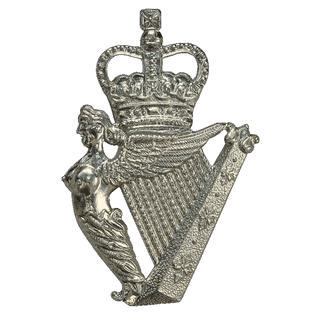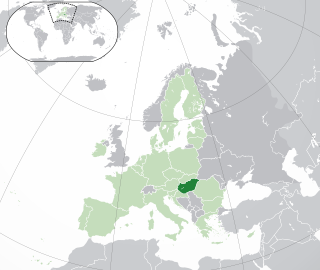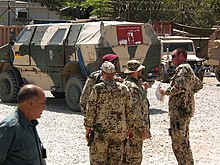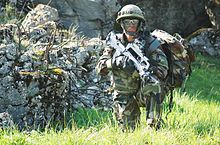
The International Security Assistance Force (ISAF) was a multinational military mission in Afghanistan from 2001 to 2014. It was established by United Nations Security Council Resolution 1386 pursuant to the Bonn Agreement, which outlined the establishment of a permanent Afghan government following the U.S. invasion in October 2001. ISAF's primary goal was to train the Afghan National Security Forces (ANSF) and assist Afghanistan in rebuilding key government institutions; it gradually took part in the broader war in Afghanistan against the Taliban insurgency.

The European Gendarmerie Force (EUROGENDFOR) is a European rapid reaction force composed of elements of several European police and gendarmerie forces. EUROGENDFOR is tasked with performing policing tasks within the scope of crisis management operations.

The Royal Irish Regiment is an infantry regiment of the British Army. The regiment was founded in 1992 through the amalgamation of the Royal Irish Rangers and the Ulster Defence Regiment. Their oldest predecessor, the 27th Regiment of Foot, was first raised in June 1689 to fight in the Williamite War in Ireland. Other notable regiments in their lineage include the Royal Inniskilling Fusiliers, Royal Irish Rifles and the Royal Irish Fusiliers.
Canada's role in the Afghanistan War began in late 2001. Canada sent its first element of soldiers secretly in October 2001 from Joint Task Force 2, and the first contingents of regular Canadian Armed Forces (CAF) troops arrived in Afghanistan in January–February 2002. The operations were aimed at identifying and neutralizing Al-Qaeda members in that country and toppling the Taliban regime which was supporting international terrorism. Canada's role in the Afghan conflict grew in 2006 when Canadian troops relieved US forces in Kandahar province, taking command of the multinational brigade in the region during a major Taliban offensive.
A Military Transition Team or Transition Team, commonly abbreviated as MiTT, in the context of the United States Military, is a 10 – 15 soldier team that trains foreign national and local security forces. The term has been used in the "War on Terror" to designate groups training the Iraqi Security Forces in particular. By comparison, Afghan Army and other Afghan security forces are mentored and trained by US Embedded Training Teams (ETTs) and the Operational Mentoring and Liaison Teams (OMLTs) of other nations.

Multi National Base Tarin Kot is a former International Security Assistance Force (ISAF) installation, used after the Netherlands Armed Forces' departure by the Afghan National Army. The base was located on the outskirts of Tarinkot, the capital of Uruzgan Province in southern Afghanistan.

Embedded Training Teams or ETT is the term used by the US military since 2003 to describe conventional forces used to train and mentor Afghan forces. They were formed in 2003 under Task Force Phoenix. Although ETT refers to the Embedded Training "Team", members of the team itself commonly refer to themselves as "ETTs"

Nawzad is a small town, the centre of Nawzad District in Helmand Province, Afghanistan. It is located at 32.4000°N 64.4667°E at an altitude of 1221 metres ASL. It was the site of the Battle of Nawzad.

French forces in Afghanistan were involved in the War in Afghanistan from late 2001, until fully withdrawing by 2014. They operated within two distinct frameworks:
The NATO Training Mission-Afghanistan (NTM-A) was a multinational military organisation, activated in November 2009, tasked with providing a higher-level training for the Afghan National Army (ANA) and Afghan Air Force (AAF), including defense colleges and academies, as well as being responsible for doctrine development, and training and advising Afghan National Police (ANP). The commanding officer was dual-hatted and commanded both NTM-A and Combined Security Transition Command – Afghanistan (CSTC-A) and reported to the Commander of ISAF.
The First and Second Battles of Kakarak were fought near the village of Kakarak in the West Dorafshan district of Orūzgān Province, in southern Afghanistan. The fighting took place between Australian forces from the 1st Mentoring and Reconstruction Task Force (MRTF-1) and Taliban fighters, with the area considered to be one of the last Taliban outposts in the area. During the first action on the morning of 16 March a six-man Australian Operational Mentoring and Liaison Team (OMLT) operating with Afghan National Army (ANA) troops was contacted by a numerically superior Taliban force near the village. In the ensuing battle one Australian was killed before close air support from Dutch AH-64D Apache helicopter gunships and US aircraft allowed them to withdraw after inflicting heavy casualties on the Taliban insurgents.
The Hungary-United States Operational Mentor and Liaison Team is a military advising unit that was created through partnership between the Hungarian Ground Forces and the Ohio Army National Guard. The partnership was borne out of the National Guard Bureau's State Partnership Program and Hungary's partnership with the Ohio National Guard. Composed of varying numbers of Hungarian and United States soldiers, the OMLT deploys in six-to-seven-month rotations to Afghanistan as part of the International Security Assistance Force (ISAF), where it has the mission of mentoring, training, and combat advising an infantry kandak, or battalion, of the Afghan National Army.
Task Force Kandahar (TFK) was the formation conducting the International Security Assistance Force (ISAF) mission in Kandahar Province under ISAF Regional Command South. When it concluded its mission in summer 2011, the formation included a Canadian Forces battle group, three U.S. Army battalions, an engineer regiment, a signal squadron, Operational Mentor and Liaison Teams (OMLTs), and contributions to Operational Mentor and Advisory Teams (OMATs) and the Police Operational Mentor and Liaison Team (P-OMLT).

The Tennessee–Bulgaria National Guard Partnership is one of 25 European partnerships that make up the U.S. European Command State Partnership Program and one of 88 worldwide partnerships that make up the National Guard State Partnership Program. The Republic of Bulgaria joined by signing a bilateral affairs agreement with the U.S. Department of Defense and the state of Tennessee in 1993. Since 2015 Bulgaria also contributes troops to the Resolute Support Mission as a member of NATO.

The Indiana–Slovakia National Guard Partnership is one of 25 European partnerships that make-up the U.S. European Command State Partnership Program and one of 88 worldwide partnerships that make up the National Guard State Partnership Program. Since its inception in 1994, the Indiana and Slovakia partnership has grown steadily in its offerings, training events, and personnel.

The Michigan–Latvia National Guard Partnership is one of 25 European partnerships that make up the U.S. European Command State Partnership Program and one of 88 worldwide partnerships that make-up the National Guard State Partnership Program. A partnership was established in 1993 and serves as a model SPP program for other nations. The current focus is HNS/ Reception, Staging, Orientation, and Integration (RSOI), Chemical-Biological-Radiological-Nuclear-Environmental (CBRNE) / Disaster Response, Joint Tactical Air Control (JTAC), Air Force & base development, and Contingency Operation Support.

The Minnesota–Croatia National Guard Partnership is one of 25 European partnerships that make up the U.S. European Command State Partnership Program and one of 88 worldwide partnerships that make-up the National Guard State Partnership Program. The partnership began in July 1996 and has progressed from small unit exchanges to deployments as Operational Mentoring and Liaison Teams (OMLT) in support of Operation Enduring Freedom (OEF). The partnership continues to support overseas contingency operations; assist in the development of disaster preparedness and consequence management, and support the EUCOM Commander's Security Cooperation Objectives.

The Ohio–Hungary National Guard Partnership is one of 25 European partnerships that make-up the U.S. European Command State Partnership Program and one of 88 worldwide partnerships that make up the National Guard State Partnership Program. The country of Hungary signed a bilateral affairs agreement with the U.S. Department of Defense and the state of Ohio in 1993 establishing the Ohio-Hungary State Partnership program. There is a large population of Hungarians throughout Ohio, especially in Columbus, Cleveland, Dayton and Toledo. Since then, Ohio and Hungary have conducted over 150 SPP events in a host of security cooperation activities ranging from bilateral familiarizations, small unit exchanges, exercises, senior military and civic leader visits to deployments of Operational Mentoring and Liaison Teams (OMLT) in support of Operation Enduring Freedom.

Forward Operating Base Arnhem or more simply FOB Arnhem is a former International Security Assistance Force (ISAF) Forward operating base which was located in Nahri Saraj District, Helmand Province, Afghanistan.
Major General Klas Carl Gunnar Eksell is a retired Swedish Army officer. He served as the Director of Human Resource at the Swedish Armed Forces Headquarters from 2016 to 2022.
















